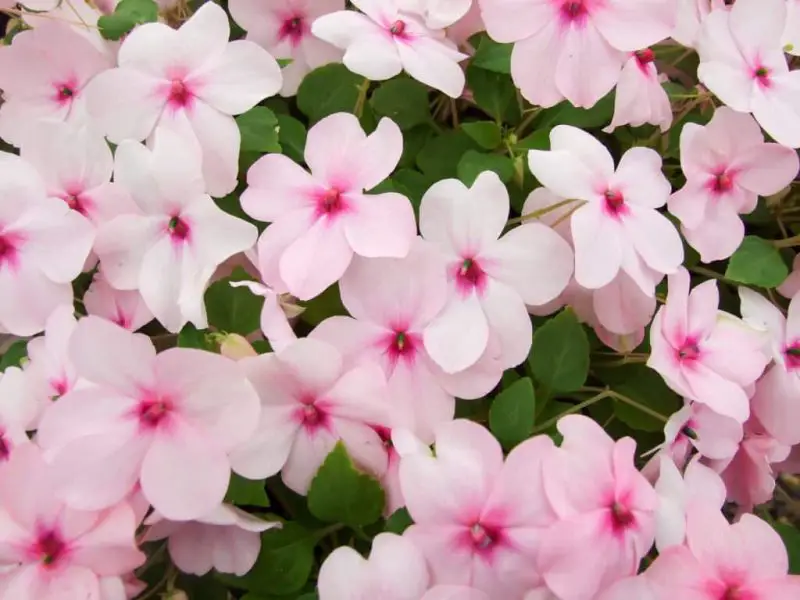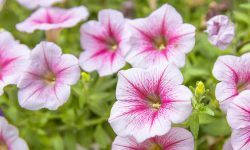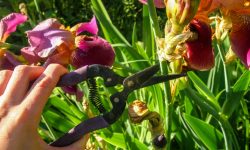Impatiens bring soft beauty, vibrant color, and a sense of calm to every corner of the garden—from shady walkways to hanging baskets on a sunny porch. With their cheerful blooms, long-lasting flowers, and ability to thrive in low light, impatiens are the perfect choice for anyone looking to add gentle charm and steady color to their outdoor space.
In this guide, you’ll learn how to plant impatiens the right way and keep them blooming all season long. Whether you’re new to gardening or have years of experience, these practical tips will help you grow lush, colorful impatiens that brighten your garden from spring through fall.
Choosing the Right Impatiens Varieties

Choosing the right impatiens variety ensures strong growth and vibrant blooms. While all impatiens thrive in shade and produce colorful flowers, different types are suited for different conditions.
Impatiens walleriana, the classic shade-loving type, blooms well in partial to full shade and is ideal for woodland gardens and shaded porches. However, in humid climates, they’re prone to downy mildew, so disease-resistant types like ‘Beacon’ or ‘Imara XDR’ are better choices.
New Guinea impatiens are larger, more sun-tolerant, and have bold foliage. They do well in spots with morning sun and afternoon shade and show better mildew resistance.
SunPatiens are heat- and sun-tolerant hybrids perfect for full-sun areas and summer heat. They’re vigorous, disease-resistant, and ideal for large containers or bright garden beds.
Consider plant size and growth habit—compact forms suit small spaces, while spreading types work well in hanging baskets or larger beds. With colors from white to deep red and even bi-color blooms, there’s a variety for every setting. Matching plant type to your garden’s conditions is key to season-long success.
When to Plant Impatiens for Best Results
Wait Until After the Last Frost
Impatiens are tropical in origin and highly sensitive to cold temperatures. Even a light frost can cause significant damage, leading to blackened leaves, root injury, or even death. That’s why waiting until after the final frost date is crucial. In most temperate areas, this means planting in mid to late May, but timing can vary greatly by region. You can find your area’s average last frost date from local agricultural extensions or online gardening tools. After this date, continue to monitor nighttime temperatures to ensure they consistently remain above 50°F (10°C) before you begin planting.
Planting impatiens too early—even if daytime temperatures seem warm—can shock the plants. Cold nights and chilly soil conditions often lead to yellowing foliage, stunted growth, and susceptibility to diseases such as root rot and downy mildew.
Check Soil Temperature for Best Growth
While air temperature is important, soil temperature plays a more significant role in root development. Impatiens grow best when the soil is consistently above 60°F (15°C). Below this threshold, roots become stressed, water uptake slows, and the plants may sit dormant or decline. Use a soil thermometer to measure the temperature at a depth of 2 to 3 inches in the early morning.
Warming the soil before planting is possible by using black plastic mulch or raised beds that heat up faster. If the soil remains cold and soggy, wait a few more days. Planting when the soil is adequately warm ensures that impatiens will root quickly, grow vigorously, and establish a strong foundation for continuous blooming.
Regional Timing Guidelines
Your local climate zone will ultimately determine the best planting window for impatiens. In warm southern regions like USDA Zones 9–11 (e.g., Florida, southern Texas, southern California), you can safely plant impatiens outdoors as early as late February through April. These areas rarely experience frost, and soil temperatures warm up quickly in spring.
In contrast, gardeners in USDA Zones 4–6 (e.g., the Upper Midwest and Northeast) must wait until late May or even early June. In these cooler climates, spring often brings unpredictable weather, and late frosts can occur well into May. For gardeners in mountain regions or areas with a short growing season, it’s even more important to plant at the right time to ensure the longest bloom period.
Using frost blankets or protective covers can help you get a small head start, but planting too early still carries risk unless conditions are ideal.
Starting Seeds Indoors
For a head start on the growing season, many gardeners choose to start impatiens from seed indoors. This should be done 8 to 10 weeks before your last expected frost date. Since impatiens seeds are tiny and light-sensitive, they should be sown on the surface of a moist seed-starting mix and pressed down gently rather than covered with soil.
Keep the seed trays in a warm environment around 70–75°F (21–24°C) with plenty of bright light. Germination usually occurs within 7 to 21 days. After seedlings develop two to three true leaves, they can be transplanted into larger pots and hardened off by gradually introducing them to outdoor conditions over the course of 7 to 10 days.
This approach allows you to grow a wider range of impatiens varieties, including rare or specialty cultivars not commonly available at garden centers. It also ensures that your plants are strong, healthy, and ready to bloom as soon as they’re moved outside.
Don’t Rush Planting for Long-Term Success
While early planting may seem like a shortcut to a colorful garden, impatiens will not thrive unless conditions are just right. Rushing to plant them in cold soil or before frost risk has passed can set them back significantly. Instead of blooming vigorously, they may become stressed, leading to spindly stems, weak roots, or early disease problems.
Taking the time to monitor temperatures, assess your site conditions, and wait for consistently warm weather results in healthier plants and a more rewarding display. Once settled in warm soil with stable conditions, impatiens will grow quickly, fill out beautifully, and produce a blanket of color that lasts until the first frost in fall.
Patience at the beginning of the season ensures months of reliable blooms and far less work trying to rescue struggling plants.
Preparing the Soil for Impatiens
For impatiens to thrive and bloom profusely, they need loose, fertile, and well-draining soil. Start by loosening the top 8 to 10 inches to improve aeration and root growth. Mix in plenty of organic matter such as compost or well-rotted manure to enrich the soil and help it retain moisture without becoming soggy.
Impatiens prefer a slightly acidic to neutral pH between 6.0 and 7.0. If needed, adjust the pH using lime to raise it or sulfur to lower it. Avoid heavy clay soils or areas prone to waterlogging, as overly wet conditions can lead to root rot. If drainage is poor, consider using raised beds or containers filled with high-quality potting mix that includes perlite or vermiculite.
Clear the area of weeds and debris before planting, and level the soil for even moisture distribution. Proper soil preparation gives your impatiens the strong foundation they need to grow vigorously and bloom continuously throughout the season.
How to Plant Impatiens the Right Way
Planting impatiens correctly from the beginning ensures healthy roots, steady growth, and a long-lasting floral display. Whether you’re planting directly into garden beds or containers, attention to detail during this step sets the tone for the rest of the season. Here’s how to do it properly:
Spacing and Layout for Healthy Growth
Begin by planning the layout of your planting area. Impatiens should be spaced about 8 to 12 inches apart, depending on the variety and how full you want the planting to look. Compact types may need less space, while vigorous growers like SunPatiens or New Guinea impatiens require more room to expand. Proper spacing improves airflow around each plant, helping prevent fungal diseases and promoting even growth.
Mark the planting spots before digging to maintain even spacing. If you’re planting in clusters or mass beds, stagger the plants in a triangular pattern for a natural, full appearance.
Preparing the Planting Hole
Dig each hole just deep enough so that the top of the root ball will sit level with the surrounding soil. The width should be slightly larger than the plant’s root ball to give roots space to spread out. For container-grown seedlings, gently squeeze the pot to loosen the plant and lift it out carefully, keeping the root ball intact.
If the roots appear tightly bound or circling the container, lightly tease them apart with your fingers. This encourages outward growth and helps the plant establish more quickly once in the ground.
Planting and Backfilling
Place the impatiens into the hole so the top of the root ball aligns with the soil surface. Avoid planting too deeply, which can suffocate the stem and invite rot. Backfill with the original soil, gently firming it around the base of the plant to eliminate air pockets.
Water the plant thoroughly after planting to help settle the soil around the roots. This first watering is critical—it removes trapped air, hydrates the root zone, and encourages initial establishment. If planting on a hot or windy day, consider shading new transplants for the first couple of days until they adjust.
Planting in Containers
For pots and hanging baskets, choose containers with good drainage holes and at least 8 to 10 inches of depth. Fill the container with a lightweight, well-draining potting mix enriched with organic matter and a slow-release fertilizer. Avoid using heavy garden soil, which compacts quickly and hinders drainage.
Arrange the impatiens so each plant has enough space to grow and spread. The same spacing rules apply—8 to 12 inches apart—though smaller containers may require tighter grouping for visual effect. After planting, water thoroughly until water drains out the bottom of the container.
Early Care After Planting
Once your impatiens are in the ground or container, continue to monitor them closely for the first week. Keep the soil evenly moist but not soggy, and check for any signs of wilting, leaf curl, or transplant shock. If temperatures are unusually hot or sunny, temporary shade may help ease the transition.
Adding a light mulch layer around garden-planted impatiens helps retain moisture and regulate soil temperature, reducing stress on young plants. Avoid piling mulch against the stems, which can lead to rot.
By planting impatiens carefully and thoughtfully, you give them the best chance to settle in quickly and begin their season-long show of color and beauty.
Providing the Ideal Light Conditions
Understanding the light needs of your impatiens is essential for vibrant blooms and healthy growth from spring through fall. While most varieties thrive in shade, each type has specific preferences that affect their performance.
Impatiens walleriana grow best in partial to full shade with filtered sunlight or morning sun and afternoon shade. Too much direct sun can scorch leaves and fade blooms, while deep shade may result in leggy growth and fewer flowers.
New Guinea impatiens are more sun-tolerant and prefer bright indirect light or partial sun, especially morning sun with afternoon shade. Their thicker leaves and larger blooms help them handle more light, but they still need protection from harsh afternoon rays in hot areas.
SunPatiens, bred for full sun, thrive in six or more hours of direct sunlight and are ideal for sunny beds or containers. Though they can grow in shade, they bloom best in bright conditions with consistent moisture.
To choose the right spot, observe your garden’s light patterns throughout the day and match each variety to the location that fits its needs. In very hot climates, even sun-loving impatiens benefit from some afternoon shade, while in cooler areas, slightly more sun may help boost flowering. Placing your impatiens in their ideal light conditions ensures a season full of vibrant, healthy blooms.
Watering Techniques for Healthy Impatiens
Watering is one of the most important aspects of caring for impatiens, as these plants thrive in moist, well-drained soil. Keeping the soil evenly moist—not too dry and not too soggy—encourages steady growth, vibrant foliage, and abundant blooms throughout the growing season.
How Often to Water
Impatiens require frequent watering, especially during warm weather or when planted in containers. As a general rule, water when the top inch of soil feels dry to the touch. In cool, shaded garden beds, watering every two to three days may be sufficient. However, in sunny or windy locations—or during heatwaves—daily watering might be needed. Container-grown impatiens dry out faster than those in the ground and may require twice-daily watering on very hot days.
Best Time to Water
Morning is the ideal time to water impatiens. This gives the foliage time to dry before evening, reducing the risk of mildew, leaf spot, and root rot. Avoid watering late in the day, especially in humid climates, as consistently damp leaves overnight can invite fungal problems.
How to Water Properly
Always water impatiens at the base of the plant, directly at the soil level. This ensures water goes straight to the roots where it’s needed and keeps the leaves dry, preventing disease. Use a watering can with a narrow spout or a soaker hose for garden beds to deliver water gently and evenly.
Maintaining Consistent Moisture
Impatiens dislike fluctuating soil moisture. When the soil dries out too much and is then heavily watered, the stress can cause wilting, leaf drop, and reduced flowering. To keep the moisture level consistent, apply a 1–2 inch layer of mulch around the base of your impatiens. Organic mulches like shredded bark, compost, or straw help conserve water, keep roots cool, and reduce weed competition.
Adjusting to Climate and Conditions
In rainy seasons or cooler, shaded locations, impatiens need less frequent watering. Overwatering in these conditions can lead to root rot or fungal diseases, so always check soil moisture before adding more water. On the other hand, if you live in a hot, dry, or windy climate, be extra vigilant. Wind and heat can wick moisture from the soil and leaves quickly, increasing water demand.
By tailoring your watering routine to your specific growing conditions and being consistent, you’ll help your impatiens stay lush, colorful, and healthy all season long.
Fertilizing for Continuous Blooms
Impatiens require consistent fertilization to maintain continuous blooming from spring through early fall. Choosing the right type of fertilizer is essential. A balanced water-soluble fertilizer such as 10-10-10 works well, but one with a higher phosphorus content, like 15-30-15, can help encourage more blooms. For those who prefer organic gardening, options like fish emulsion, seaweed extract, or compost tea are also effective.
Begin fertilizing about two weeks after planting, once the roots are established. Apply water-soluble fertilizer every two to three weeks for garden beds. For impatiens grown in containers, more frequent feeding—usually once a week with a diluted solution—is recommended since nutrients leach out faster due to watering. Always water the plants before applying fertilizer to prevent root burn, and apply fertilizer to the soil rather than the foliage to avoid damage. If you notice lush green growth but few flowers, it may be a sign of excessive nitrogen. In that case, reduce the feeding rate or switch to a bloom-boosting formula. With the right fertilization approach, impatiens will thrive and deliver vibrant color all season long.
Pruning and Deadheading Impatiens for Maximum Bloom
Pruning and deadheading impatiens are essential practices that help encourage fuller plants and more continuous blooming throughout the season. While impatiens are naturally self-cleaning and don’t always require deadheading, giving them a little attention can make a big difference in their overall appearance and flower production.
Start by regularly checking your plants for spent blooms or fading flowers. Gently pinch off the old blooms just above a leaf node to redirect the plant’s energy into producing new buds rather than forming seeds. This simple act stimulates growth and encourages the plant to bloom more profusely.
In addition to deadheading, occasional light pruning can improve the shape and vigor of the plant. If your impatiens become leggy or spindly—especially in mid to late summer—use clean, sharp scissors or your fingers to trim back one-third of the plant’s height. This encourages bushier growth and more branching, which naturally leads to more flower sites.
For container-grown impatiens, pruning is especially useful to maintain a compact, lush form. For bedding impatiens, thinning out dense patches improves air circulation and helps prevent diseases like powdery mildew. Regular care through deadheading and pruning not only keeps your impatiens looking neat and vibrant but also ensures a season-long floral display that remains full and eye-catching.
Managing Pests and Diseases
Managing pests and diseases is crucial for keeping your impatiens healthy and thriving all season long. Although impatiens are relatively low-maintenance, they can still fall victim to common garden issues if not properly cared for.
One of the most serious threats to impatiens is downy mildew, a fungal-like disease that causes yellowing leaves, leaf drop, and eventually plant death. It spreads quickly in humid, wet conditions, especially when airflow is poor. To prevent it, avoid overhead watering, space plants adequately, and choose disease-resistant varieties when possible. If you notice signs of downy mildew, remove infected plants immediately and treat the surrounding area with a fungicide if needed.
Aphids, spider mites, and thrips are some of the most common insect pests that affect impatiens. These pests can cause distorted growth, sticky residue on leaves, and a general decline in plant health. Regularly inspect the undersides of leaves and new growth for signs of infestation. You can control these pests using insecticidal soap, neem oil, or by simply spraying the plants with a strong stream of water to dislodge the bugs.
Fungal issues like gray mold (Botrytis) or root rot may also occur in overly damp conditions. Ensure your soil drains well, avoid overcrowding, and water only at the base of the plant to reduce moisture on the foliage.
With regular observation, proper spacing, and preventative care, most pest and disease problems can be managed before they become severe. Healthy impatiens will reward you with months of lush, colorful blooms.
Mulching to Retain Moisture and Suppress Weeds
Mulching plays a vital role in maintaining healthy impatiens by helping to conserve soil moisture, regulate soil temperature, and suppress weed growth that competes for nutrients. When applied correctly, mulch creates a protective barrier over the soil, reducing evaporation and keeping the root zone consistently moist—especially important during hot summer days when impatiens are most active in growth and blooming.
Organic mulches such as shredded bark, compost, pine needles, or leaf mold are ideal for impatiens. These materials not only hold moisture well but also improve soil structure and fertility over time as they decompose. Apply a 2–3 inch layer of mulch around your impatiens, being careful to keep it a few inches away from the base of the stems to prevent excess moisture buildup and potential rot.
In addition to water retention, mulch greatly reduces the number of weeds that can establish themselves near your plants. Fewer weeds mean less competition and fewer pests that might use weeds as hiding spots. Mulching also minimizes soil splashing during rainfall or watering, which helps protect impatiens from soil-borne diseases.
For container-grown impatiens, you can add a thin layer of fine mulch like compost or coconut coir on top of the potting mix. This helps reduce watering frequency while keeping the root zone cool and shaded.
With the simple act of mulching, you create a more stable, low-maintenance growing environment where impatiens can flourish with vibrant, long-lasting blooms.
Growing Impatiens in Containers and Hanging Baskets
Growing impatiens in containers and hanging baskets is a beautiful and practical way to brighten up shaded patios, balconies, window boxes, and porch areas. These adaptable plants thrive in confined spaces when given the right care and growing conditions. Start by choosing containers with proper drainage holes to prevent water from collecting at the bottom, which can lead to root rot. Use a high-quality, lightweight potting mix enriched with organic matter like compost or peat moss to support healthy root development and good moisture retention.
When planting, space impatiens properly based on the variety to allow good airflow and reduce the risk of fungal issues. Water your plants regularly—often daily during hot summer months—as containers and baskets dry out more quickly than in-ground plantings. Make sure the soil stays evenly moist but not soggy. Place the containers in a location that receives bright, indirect light or morning sun with afternoon shade, which mimics the conditions impatiens love in their native tropical habitats.
For hanging baskets, trailing or mounding varieties like ‘Infinity’ or ‘SunPatiens’ create a full, cascading effect. To encourage bushier growth and more flowers, regularly deadhead faded blooms and pinch back leggy stems. Fertilize every two weeks using a diluted, balanced liquid fertilizer to support continuous blooming. If possible, rotate pots and baskets occasionally so all sides of the plant get even light exposure and grow symmetrically.
With consistent care and attention, impatiens grown in containers and hanging baskets will reward you with months of vibrant color and lush foliage, making them an ideal choice for urban spaces or gardeners with limited ground area.
How to Overwinter Impatiens
Overwintering impatiens allows you to enjoy your favorite varieties year after year, especially in colder climates where they can’t survive frost. Before the first frost arrives, dig up healthy plants and transplant them into small pots using fresh, well-draining potting mix. Trim back about one-third of their growth to reduce stress and encourage compact regrowth indoors.
Place the pots in a bright, warm area indoors—such as near a sunny window with indirect light—and keep the soil slightly moist but not soggy. Avoid overwatering, as reduced winter light levels slow down growth. Maintain indoor temperatures between 60–70°F (15–21°C) and protect from cold drafts.
Alternatively, you can take stem cuttings before frost hits. Root them in water or moist potting mix, then grow them indoors through winter. In spring, once the danger of frost has passed, gradually acclimate the plants to outdoor conditions before replanting them in the garden. This method ensures you can preserve favorite impatiens varieties without starting from seed each year.
Troubleshooting Common Impatiens Problems
Yellowing Leaves
Yellowing leaves on impatiens are often the first sign that something is wrong, and they typically indicate a moisture imbalance. Overwatering is the most common culprit—when the roots are constantly sitting in soggy soil, they lose access to oxygen, which leads to chlorosis (yellowing) and poor nutrient uptake. This issue is particularly common in heavy or compacted soil that doesn’t drain well.
However, underwatering can also cause leaf yellowing, especially during hot weather when impatiens need consistent moisture. Another possible cause is a lack of nutrients, particularly nitrogen or iron. A slow-release, balanced fertilizer can help correct deficiencies.
To fix the issue, check the soil moisture level before watering again, ensure containers have adequate drainage holes, and consider amending garden beds with organic matter to improve drainage and nutrient retention.
Wilting Plants
Wilting is a confusing symptom because it can signal both too little and too much water. If the soil is dry and crumbly, then the plant likely needs more frequent watering. Impatiens thrive in evenly moist soil and can wilt quickly in heat if not properly hydrated.
On the other hand, if the soil feels soggy and heavy and wilting still occurs, the roots may be suffering from rot or oxygen deprivation. In such cases, gently unearth the plant and examine the roots—brown, mushy roots indicate rot, whereas white, firm roots are healthy.
To prevent wilting due to water stress, water consistently and early in the morning, and never let the soil become bone-dry or overly saturated. For root rot cases, remove infected portions and replant in fresh, well-drained soil.
Fungal Diseases (Downy Mildew)
Downy mildew is one of the most devastating diseases that affect impatiens, especially the traditional Impatiens walleriana varieties. It is caused by a water mold (Plasmopara obducens) that spreads rapidly in moist, humid conditions and thrives in overcrowded garden beds.
Initial symptoms include yellowing and curling leaves, a white downy growth on the undersides, and eventual defoliation. Once infected, plants usually cannot recover and should be removed and discarded—not composted—to prevent further contamination.
To avoid fungal diseases, water at the soil level rather than from above, provide good airflow by spacing plants properly, and avoid overcrowding. Choose disease-resistant varieties like New Guinea impatiens or hybrids like SunPatiens if downy mildew has been an issue in your area.
Lack of Blooms
If your impatiens are growing well but producing few or no flowers, it’s likely due to one of three reasons: insufficient light, nutrient imbalance, or stress from environmental conditions.
Although impatiens are shade-loving plants, they still need some bright, indirect light or dappled sunlight to flower profusely. In deep shade, flowering may slow significantly. In containers, plants may also become root-bound or nutrient-depleted over time, leading to stunted flowering.
Another factor is over-fertilization with high-nitrogen fertilizers, which promote lush green leaves but suppress flower formation. Switch to a balanced fertilizer with higher phosphorus (e.g., 10-20-10) and reduce feeding frequency if you suspect overfertilization.
Regular deadheading and pruning can also help redirect energy into bloom production rather than leafy growth.
Insect Pests
Several pests are known to target impatiens, with aphids, spider mites, whiteflies, and thrips being the most common. These insects feed by piercing plant tissues and sucking out sap, which weakens the plant and can spread viruses.
Aphids often cluster on new growth and leave behind a sticky residue called honeydew, which can attract sooty mold. Spider mites are more subtle, appearing as tiny specks on the undersides of leaves and leaving fine webbing as their population grows. Thrips cause distorted or discolored petals, particularly on budding flowers.
Early detection is crucial. Inspect plants regularly, especially during dry spells, and treat infestations promptly using insecticidal soap, neem oil, or horticultural oils. For severe outbreaks, remove affected leaves or plants to protect nearby healthy ones.
Leggy Growth
Leggy impatiens are usually the result of inadequate light or lack of pruning. In low-light environments, the plant stretches toward available light, resulting in tall, weak stems with sparse foliage and fewer blooms.
Another reason for leggy growth is the natural tendency of impatiens to elongate over time if not pinched back. Regular pruning or pinching of the tips encourages branching, resulting in a fuller, bushier plant with more flower sites.
To address this, move the plant to a brighter but indirect light location if possible and begin a gentle pinching routine, removing the top inch or two of each stem. This practice can be repeated throughout the growing season to maintain compactness and vigor.
Companion Plants for Impatiens
Impatiens thrive alongside many other shade-loving plants, making them a versatile choice for mixed garden beds, borders, and containers. Ideal companions include hostas, whose broad, textured foliage offers a beautiful contrast to the soft petals of impatiens. Ferns are another excellent choice—their airy, delicate fronds provide a fine-textured backdrop that highlights impatiens’ bold colors. For an extra splash of vibrancy, coleus adds colorful foliage in shades that either complement or contrast with impatiens blooms, creating dynamic visual interest throughout the growing season.
If you’re looking to add height and depth to your impatiens display, consider pairing them with caladiums or astilbes. Caladiums offer heart-shaped leaves in dramatic patterns, while astilbes contribute elegant, plume-like flowers that bloom beautifully in partial shade.
All these companion plants share similar growing requirements—preferring rich, well-draining soil, consistent moisture, and filtered sunlight—so they work in harmony without competing for resources. Moreover, companion planting with impatiens helps suppress weeds, improve ground coverage, and attract beneficial insects to the garden, promoting a healthier and more vibrant landscape overall.
Final Tips to Keep Impatiens Blooming All Season Long
To keep impatiens blooming all season long, maintain consistent care and adjust as conditions change. Water regularly, keeping the soil evenly moist but not soggy, especially during hot weather. Feed every 2–3 weeks with a balanced, water-soluble fertilizer to promote continuous flowering. Make sure your plants get partial shade with bright, indirect light—too much sun can stress them, while too much shade reduces blooms. Although most impatiens are self-cleaning, occasional deadheading or light pruning helps encourage new growth and flowers. Keep an eye out for pests like aphids or spider mites and treat issues early. Refresh mulch mid-season and clean up fallen leaves to prevent disease. With this steady attention, impatiens will reward you with vibrant blooms from spring through fall.
FAQ: Common Questions About Growing Impatiens
Why are my impatiens not blooming?
Lack of blooms is often caused by insufficient light, poor soil nutrition, or plant stress from temperature and moisture extremes. Impatiens bloom best in bright, indirect light and well-draining, fertile soil. Regular feeding every 2–3 weeks with a water-soluble fertilizer high in phosphorus can promote more flowers. Also, light pruning encourages new growth and blooming. Check for signs of pests or diseases that may also hinder flowering.
How often should I water impatiens?
Impatiens prefer consistently moist soil, but not soggy. During hot summer months, daily or every-other-day watering may be needed, especially for container-grown plants. In cooler weather or when grown in mulched beds, watering two to three times a week may be enough. The best way to gauge watering needs is to feel the soil—if it’s dry about 1 inch below the surface, it’s time to water.
Can impatiens grow in full shade?
Impatiens grow best in partial to full shade with filtered sunlight or morning sun. In deep shade, they may survive but grow leggy and produce fewer blooms. If your garden receives no direct light at all, consider using supplemental grow lights or planting more shade-tolerant varieties like New Guinea impatiens, which can handle slightly brighter conditions.
When should I prune impatiens?
Although impatiens are self-cleaning, occasional pruning helps maintain a bushier shape and encourages more flowers. Trim back any leggy stems, yellowing leaves, or spent blooms every couple of weeks, ideally in the early morning or late afternoon. Pruning improves airflow around the plant, reduces disease risk, and keeps the plant compact and lush.
How can I protect impatiens from downy mildew?
Downy mildew is a serious disease for impatiens, causing yellowing leaves, white fungal growth on leaf undersides, and plant collapse. To prevent it, provide good air circulation, avoid overhead watering, and ensure the soil isn’t overly wet. At the first signs of disease, remove affected plants immediately and treat nearby ones with a bio-fungicide or appropriate chemical spray. For added protection, choose resistant varieties like those in the ‘Beacon’ or ‘Imara’ series.
Conclusion
Learning how to plant impatiens and keep them blooming all season long unlocks one of the easiest ways to bring vibrant color to your garden. Whether nestled in shady corners or spilling from hanging baskets, these cheerful flowers are versatile and rewarding. By selecting the right varieties, giving them the care they need, and staying attentive to their environment, you’ll enjoy a spectacular floral display that lasts from spring until the first frost.






